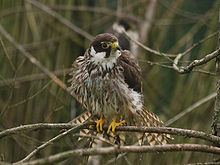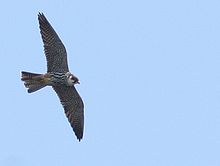- Eurasian Hobby
-
Eurasian Hobby 
Conservation status Scientific classification Kingdom: Animalia Phylum: Chordata Class: Aves Order: Falconiformes Family: Falconidae Genus: Falco Species: F. subbuteo Binomial name Falco subbuteo
Linnaeus, 1758The Eurasian Hobby (Falco subbuteo), or just simply Hobby, is a small slim falcon. It belongs to a rather close-knit group of similar falcons often considered a subgenus Hypotriorchis.[2]
Contents
Description
Adults are slate-grey above with a dark crown and 2 short black moustachial stripes. The throat is unstreaked white, thighs and undertail coverts are unstreaked rufous and rest of the underparts are whitish with black streaks. Close views enable the red "trousers" and vent to be seen. Sexes are similar. Juveniles are generally much browner, with scaled upper parts and streaked buffy thighs and undertail coverts.[3]
The Hobby has a distinct first-summer plumage.[4]
Taxonomy and systematics
This species was first described by Linnaeus in his Systema naturae in 1758 as Falco subbuteo.[5]
Currently two subspecies are recognized:
- subbuteo - the nominate race is resident in Africa, Europe and Central and East Asia, winters in Central and South Africa and South Asia
- streichi, described by Hartert and Neumann in 1907, is smaller in size and is found further east of subbuteo's distribution range
Distribution and status
This species breeds across Africa, Europe and Asia. It is a long-distance migrant, wintering in Africa and Asia.
Behaviour and ecology
It is a bird of open country such as farmland, marshes, taiga and savannah. They are widespread in lowlands with scattered small woods. It is an elegant bird of prey, appearing sickle-like in flight with its long pointed wings and square tail, often resembling a swift when gliding with folded wings. It flies powerfully and fast. It will take large insects, such as dragonflies, which it transfers from talons to beak and eats while soaring slowly in circles.[6] It also captures small bats and small birds like swallows, swifts, pipits etc. in flight. Its speed and aerobatic skills enable it to take swallows and even swifts on the wing, and Barn Swallows or House Martins have a characteristic "hobby" alarm call. It is known to harass swallows while they are roosting and dispersing from roosts.[3] When not breeding, it is crepuscular, hawking principally in the mornings and evenings. While on migration, they may move in small groups.
Hobbies nest in old nests of crows and other birds. The tree selected is most often one in a hedge or on the extreme edge of a spinney, whence the bird can observe intruders from a considerable distance. It lays 2-4 eggs. Incubation is said to take 28 days and both parents share in this duty, though the female does the greater part.[7]
It is a very bold and courageous bird and was used in falconry, trained to hawk birds like quails, larks, hoopoes, drongos etc.[8]
Notes
- ^ "Falco subbuteo". IUCN Red List of Threatened Species. Version 2007. International Union for Conservation of Nature. 2004. http://www.iucnredlist.org/apps/redlist/details/144569. Retrieved 12 May 2006. Database entry includes justification for why this species is of least concern
- ^ Helbig et al. (1994), Wink et al. (1998), Nittinger et al. (2005)
- ^ a b Rasmussen PC & JC Anderton (2005). Birds of South Asia: The Ripley Guide. Volume 2. Smithsonian Institution & Lynx Edicions. pp. 114–115.
- ^ Small, Brian (1992): First-summer Hobbies in the New Forest British Birds 85(5): 251-5
- ^ (Latin) Linnaeus, C (1758). Systema naturae per regna tria naturae, secundum classes, ordines, genera, species, cum characteribus, differentiis, synonymis, locis. Tomus I. Editio decima, reformata.. Holmiae. (Laurentii Salvii).. pp. 89. "F. cera pedibusque flavis, dorso fusco, nucha alba abdomine pallido maculis oblongis fuseis."
- ^ Butler, EA, (1875). "Notes on the Avifauna of Mount Aboo and Northern Guzerat". Stray Feathers 3: 443–444. http://www.archive.org/stream/strayfeathersjou31875hume#page/443/mode/1up.
- ^ Baker, ECS (1928). Fauna of British India. Birds. Volume 5 (2 ed.). Taylor and Francis, London. pp. 41–45. http://www.archive.org/stream/BakerFbiBirds5/BakerFBI5#page/n59/mode/1up.
- ^ Jerdon, TC (1864). The birds of India. Volume 1. George Wyman and Co, Calcutta. pp. 34–35. http://www.archive.org/stream/birdsofindiabein01jerd#page/33/mode/1up.
References
- Helbig, A.J.; Seibold, I.; Bednarek, W.; Brüning, H.; Gaucher, P.; Ristow, D.; Scharlau, W.; Schmidl, D. & Wink, Michael (1994): Phylogenetic relationships among falcon species (genus Falco) according to DNA sequence variation of the cytochrome b gene. In: Meyburg, B.-U. & Chancellor, R.D. (eds.): Raptor conservation today: 593-599. PDF fulltext
- Nittinger, F.; Haring, E.; Pinsker, W.; Wink, Michael & Gamauf, A. (2005): Out of Africa? Phylogenetic relationships between Falco biarmicus and other hierofalcons (Aves Falconidae). Journal of Zoological Systematics and Evolutionary Research 43(4): 321-331. doi:10.1111/j.1439-0469.2005.00326.x PDF fulltext
- Wink, Michael; Seibold, I.; Lotfikhah, F. & Bednarek, W. (1998): Molecular systematics of holarctic raptors (Order Falconiformes). In: Chancellor, R.D., Meyburg, B.-U. & Ferrero, J.J. (eds.): Holarctic Birds of Prey: 29-48. Adenex & WWGBP. PDF fulltext
External links
Categories:- IUCN Red List least concern species
- Falco
- Birds of Bhutan
- Birds of Iran
- Birds of Pakistan
- Birds of Europe
- Birds of Turkey
Wikimedia Foundation. 2010.



